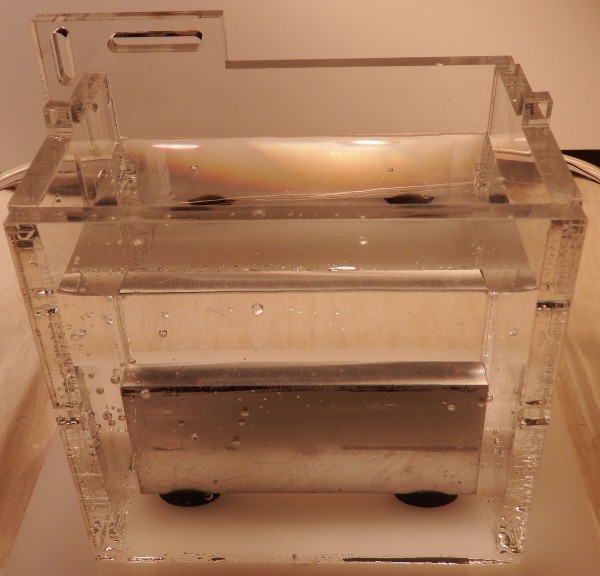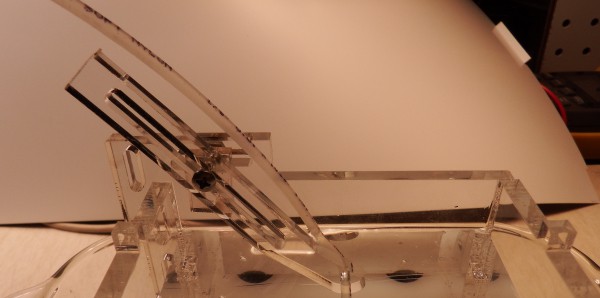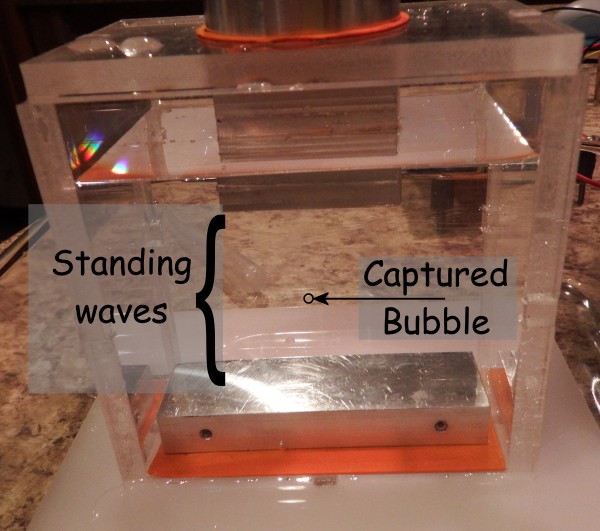.) Reaction chamber v3.0
.) Complete list of components, $50 total cost
.) Trying a "bubble plate"
.) Capturing bubbles in a standing wave works... 'sorta
Reaction chamber, v3.0
The tube holder for the reaction chamber was a bit unwieldy, so I added mounting tabs to the back plate of the reaction chamber and changed the lid as needed.
The new version holds the tube firmly in place, and has extra mounting holes for future use.
The chamber layout is now based on a specific thickness and vendor for acrylic (Plaskolite, 5.75mm), so it's easy for anyone to cut out and assemble.
To use a different thickness you'll have to resize the tabs and notches - if I get time after the contest maybe I'll make a parametric program that generates the pattern based on the thickness the user has available.


Completed list of components
The Hackaday.io project components are complete and final (I hope!). All chips are listed, except I glossed over minor electronic things like passives and XOR gates and such.
The final list of components are:
- 1 × Ultrasonic Transducer (Available from eBay for under $20).
- 1 × 100mm of 6061 aluminum rod (To make a tuned aluminum horn. About $10 on eBay).
- 2 × ATX power supply (One supply for power, one to scavenge the SMPS transformer).
- 1 × Arduino nano (Control board interface).
- 1 × UC3525 Pulse width modulator IC.
- 1 × MCP4161 10K Digital potentiometer.
- 1 × MCP4131 50K Digital potentiometer.
- 1 × AD9833 Sin/Square/Triangle generator (About $6 on eBay).
- 1 × ACS712 Hall effect current sensor.
- 1 × PCB, assorted passives.
- 1 × Transducer mount (made from wood or acrylic, or whatever).
With parts from eBay the whole system costs around $50, not counting the 2 ATX supplies.
Bubble Plate
Holding a bubble at the end of the gas inlet tube is proving to be problematic. There's a fine line between having a bubble and either a) no bubble, or b) releasing a bubble.
I want the bubble held stationary, so I machined a concave depression into the head of a small bolt. This will attach to the gas inlet tube and serve as a catcher plate for released bubbles. This way I can position the bubble with the plate and not have to worry about keeping it at the end of the tube.
UPDATE: It works well enough, but isn't sturdily mounted to the gas tube - it keeps flipping over. Oh well - it's a nut & bolt, shouldn't be to hard to figure out a mounting bracket.

Capturing bubbles in a standing wave
Thinking about ultrasonic levitation, I got to wondering if the reverse was possible. Can a standing wave capture a bubble under water?
It turns out it can. I was able to get a bubble to "hover" above a reflecting plate for about a minute before it wandered off.
Once.
I don't have a picture because it's hard to place the bubble in just the right position. Several times I positioned the bubble, only to have it fly away a few seconds later. It was definitely hovering for those few seconds, however.
This really isn't the right horn or the right way to do this. If I get some time I'll play around some more later. Maybe a horn with a slight depression would arrange the energy to better capture the bubble.
The speed of sound in water is 1482 m/s, the frequency is 28,000 hz, so the half wavelength is 26.46 mm.
Position a flat horn any multiple of this distance over the reflecting plate to get standing waves.

 Peter Walsh
Peter Walsh
Discussions
Become a Hackaday.io Member
Create an account to leave a comment. Already have an account? Log In.